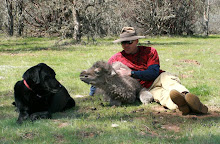
Our group of camels currently numbers eight.
Our charge is to create a facility and a process that will embody, and share, what we are calling "The Sacred Camel Gardens".
Commenced in early 2006 a small group of people have been working steadily to create the beginnings of The Sacred Camel Gardens, here in northern California.
The camels are living in an area of about 40 acres currently, with room to expand to about 100 acres overtime, if desired.
As you may know already, our camels are Bactrian camels. We like the Dromedary camels very much, but we happened to start out with a beautiful Bactrian bull and things just developed from there. We currently have some white ones, brown and tan ones and one "black" bull.
The Sacred Camel Gardens has emerged as a distinct project of the longer existing Fear-No-More Zoo and Gardens.
Both Fear-No-More Zoo and the Sacred Camel Gardens were founded by the Spiritual Teacher Adi Da Samraj, out of His love for animals, and His wish that human and non-human cultures become, eventually, one whole but very diverse culture founded in a unifying Spiritual Wisdom... for once and for all...
As of today, right now, we work humbly and simply to install the seed of this Vision of Adi Da's, such that it can grow, touch, inform and embrace all mortal beings within this world we call Earth.
Essentially it is about coming into the disposition of "fearing-no-more", embracing a deeply surrendered and Divinely contemplative existence of inter-connectedness and unity with all beings, and things, rather than living a life of intentional (or unintentional) separation from, and chronic fear toward, all beings. Sure, that's a bit of a mouthful, but if you play around with it a bit I think you might get a sense for it...
We have a Sacred Camel Gardens website under production, and will soon have it on-line. Until it's ready we'll keep it under wraps.
What we have ahead of us is a big undertaking. Fear-No-More Zoo itself is a big undertaking; add to it this further Vision that incorporates the camels and it gets even bigger.
So yes, we do need help. But we need good help of certain kinds right now. The big one being funding, but I won't go into that here, yet.
Eventually the Sacred Camel Gardens should, and will, be a self-sustaining enterprise, and it will also be able to support the rest of Fear-No-More Zoo.
Our plan is not the usual plan, because the camels themselves are part of the plan, and they influence and shape the plan... all of them as a group, and even each one individually.
Please keep reading the posts to find out more...





